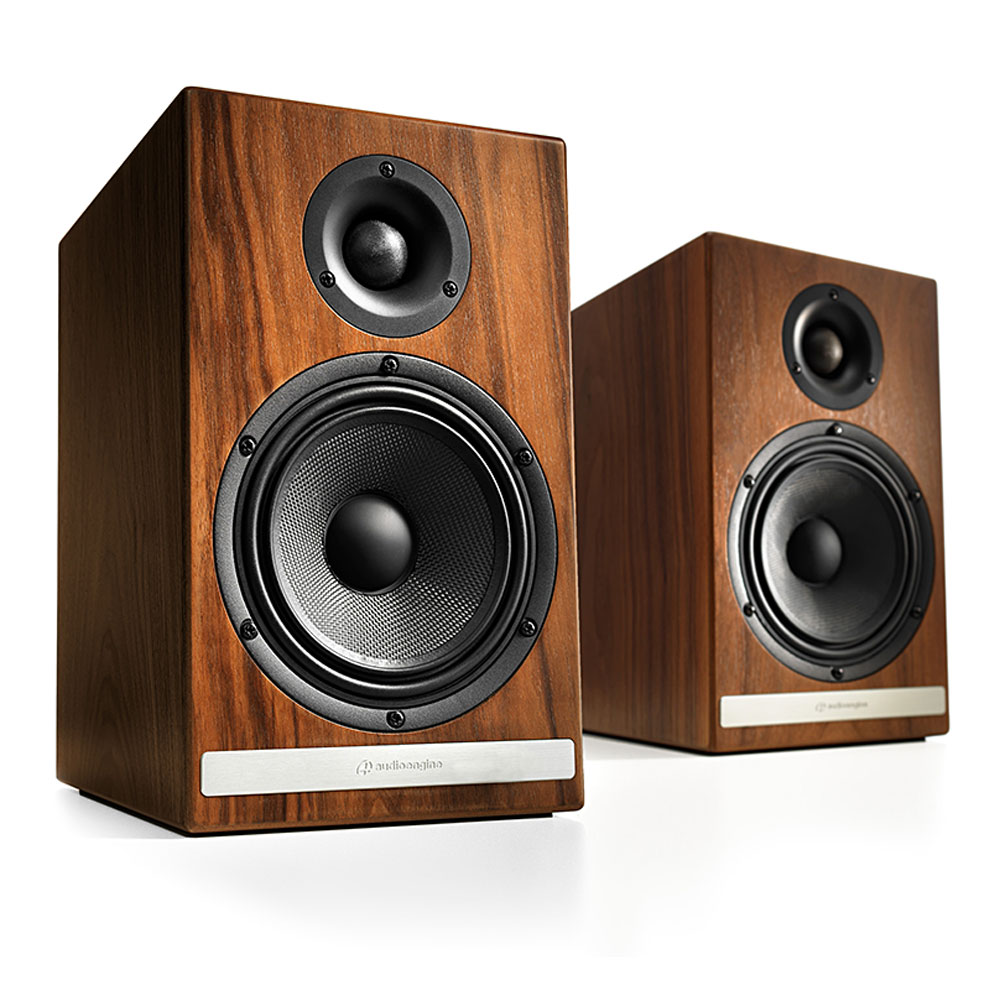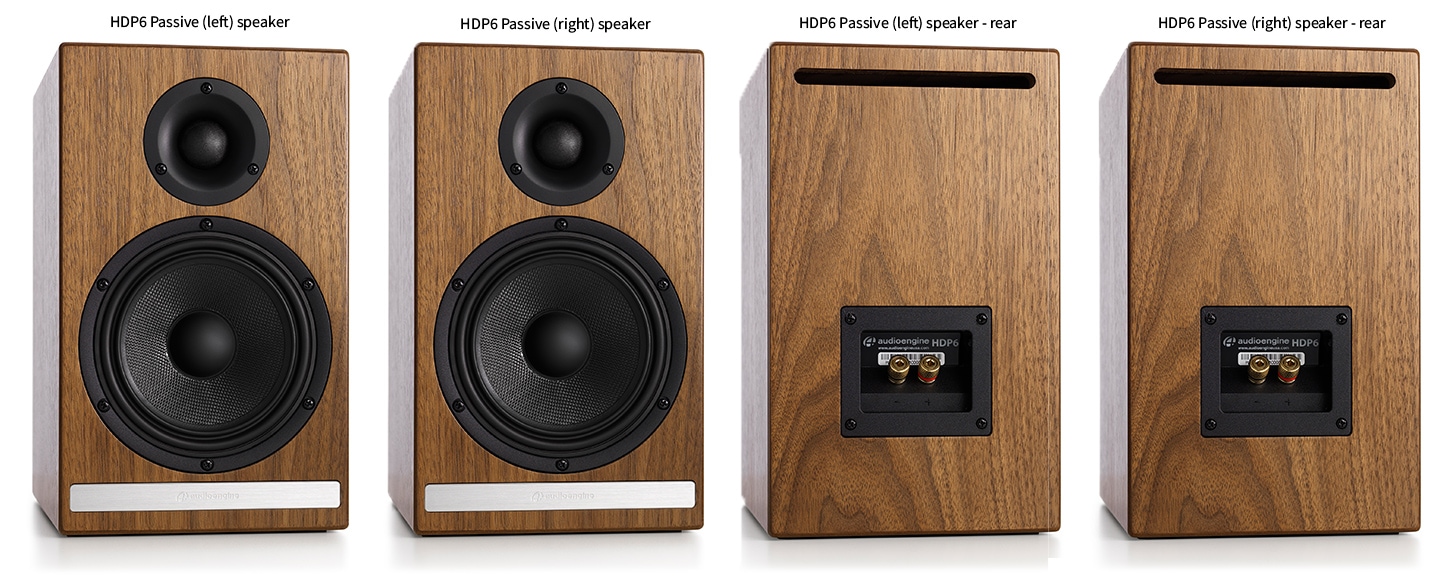
HDP6 Passive Speakers
Technical Specifications

General Specifications
Type
2-way passive speaker system, rear ported design, power amplifier or AV receiver required
Amplifier Type
N/A
Power Output
N/A
Drivers
5.5" aramid fiber woofers
1" silk dome tweeters
Inputs
Gold-plated, 5-way binding posts
Outputs
N/A
Input Voltages
N/A
SNR
N/A
THD+N
N/A
Crosstalk
N/A
Frequency Response
50 Hz-22 kHz ±1.5 dB
Frequency Response w/ Bass Reduction Switch selected
N/A
Analog Input Impedance
N/A
Nominal Impedance
4 ohms
Input Impedance
N/A
Crossover Frequency
N/A
Protection
N/A
Power Consumption
N/A
Standby Consumption
N/A
Phase
N/A
Recommended Amplifier Power
10-150 W per channel
Battery Life
N/A
Battery Charge Time
N/A
Bluetooth Specifications
Internal D/A Converter
N/A
Internal BT Receiver
N/A
Input Bit Depth
N/A
Bluetooth Receiver Type
N/A
Supported Codecs
N/A
Supported Bluetooth Profiles
N/A
Wireless Operation Range
N/A
Input Data Rate
N/A
Wireless Latency
N/A
Usb Specifications
Connector Type
N/A
USB Device Class
N/A
Input Bit Depth
N/A
Input Sample Rate
N/A
Headphone Amp Specifications
Headphone Amp Type
N/A
Full-scale Headphone Output Level
N/A
Output Impedance
N/A
Recommended Headphone Impedance Level
N/A
Optical Specifications
Internal D/A converter
N/A
Input Bit Depth
N/A
Sample Rate
N/A
Weights And Measures
Dimensions (HWD)
11.75" (29.8 cm) x 7.2" (18.3 cm) x 9.4" (23.9 cm)
Weight
12.5 lb (5.7 kg)
Total Shipping Weight
32 lb (14.5 kg)
Shipping Box Dimensions (LWH)
20" (51 cm) x 15" (38 cm) x 17" (43 cm)
Environmental Requirements
Operating temperature: 32 degrees F to 95 degrees F
Non-operating temperature: -4 degrees F to 113 degrees F
Relative humidity: 5% to 95% non-condensing
Materials And Construction
0.7" (18 mm) thick MDF cabinets with real wood veneer
1" (26 mm) silk dome tweeters with neodymium magnets
5.5" (140 mm) aramid fiber woofers with advanced voice coils
Cabinets
To minimize unwanted resonances and distortion, Audioengine cabinets have thick high-resin MDF walls with extensive internal bracing. Heavy internal sound-damping material is used to reduce unwanted sound reflections inside the cabinet. All cabinet edges are rounded which look great and reduce high-frequency diffraction effects on the front baffles. The HDP6 cabinet contains tuned, rear-port slots.
Furniture Grade Finishes
The HDP6 cabinets are available in several handsome finishes, including walnut and cherry veneers as well as satin black paint, offering a myriad options for complementing room furnishings. Also included are detachable grills that add further aesthetic advantages as they are firmly held in place with hidden neodymium magnets for a clean look.
Custom Components
Audioengine designs and manufactures our own speaker drivers and other critical components. In other words, the HDP6 is not a box-built system with off-the-shelf parts, but includes custom-designed components constructed to our specifications. What we do not fabricate directly inside our factories we have made to our specific designs and parts such as circuit boards, transformers, magnets, and wiring harnesses, for example.
Based On Studio Monitor Designs
Studio monitor speakers are used by producers and engineers in recording and production studios. They are designed with a theoretical flat frequency response which allows the engineer to create a final mix in such a way that the recorded music will sound good on most other speakers. Although Audioengine speakers are not designed to be up-close “nearfield” studio monitors, we do carry over much of the same higher-end technology, components, and design philosophy for all Audioengine speaker systems.
Driver Designs
Audioengine uses audiophile-quality, ferrofluid-cooled silk dome tweeters with neodymium magnets. Silk tweeters hold up well under high power and the edge-driven design gives very smooth response. The woofers are aramid fiber woven glass composite with rubber surrounds. Aramid fiber is obviously very strong, which means the woofer retains its shape when being driven at high levels. The HDP6 woofers are housed in cast aluminum frames which provide high rigidity and increased heat dispersion.
Troubleshooting
HDP6 and P4 Troubleshooting TipsThe following troubleshooting tips can help diagnose and correct most concerns with the HDP6 or P4. We have attempted to make this list as comprehensive as possible, so some of these may not apply to your issue, but please go through each tip.
- Verify that the power controls for your amp, preamp, and/or AV receiver are powered on and working.
- Check that the volume level of your audio source components or devices are turned up.
- Check the speaker wire connections from your amp to the speakers by removing the speaker wire from each speaker and then reconnecting. Also check the speaker wire polarity by verifying that the wires are going to the same terminals on both speakers.
- Check that the cables from your audio source(s) to the amplifier are properly connected. Confirm this by unplugging the audio cables and then reconnecting.
- Try using different audio input sources and/or devices to see if the problem follows.
- Try swapping inputs to the left and right speaker to see if the issue remains in the same channel or follows the speaker.
- If you are using a computer with your setup, make sure the volume is up on your media players, internet radio, master control, device volume, etc. and that the balance control is centered.
- If you are using a wireless adapter, preamp, or external DAC, remove these (temporarily) and connect the audio source directly to the amp/speakers.
- If your input source has its own EQ (equalizer), please make sure the low end is at a moderate level as having too much bass can cause distortion.
- Move your amp and HDP6/P4 speakers to a different location to see if something is causing interference in the current setup. Something as simple as a wireless internet router, cordless or mobile phone, or halogen lamp nearby can cause interference.
FAQ's
1. Turn Off and Unplug:
- Make sure your system is turned off and unplugged.
2. Dust the Surfaces:
- Use a soft, dry cloth to wipe away dust.
- For hard-to-reach places, use a soft brush or a can of compressed air.
3. Wipe Down the Exterior:
- We do not recommend using any solvents
- If cleaning off stains or build-up is necessary, we recommend doing so with a very small amount of mild cleaning solution applied only to the affected area, followed by quickly wiping the area dry completely.
- Any scoured pads or objects like a 'magic eraser' too easily run the risk of removing sealers and top coats of the painted finish that can leave a clearly visible change in the uniformity of the paint/finish
4. Clean the Speaker Grills:
- The speaker grills can be gently cleaned with a vacuum, preferably using a soft bush attachment.
- A lint roller can also be used.
5. Clean Buttons and Knobs:
- A dry cloth is recommend for cleaning any knobs, buttons or other surfaces
- Be careful not to let water get into any gaps.
6. Clean Ports and Connections:
- Use compressed air to blow out dust from ports and connections.
7. Let Everything Dry:
- Make sure everything is completely dry before plugging back in and turning on.
8. Regular Cleaning:
- Dust your system regularly to keep it in good shape.
By following these steps, you can keep your Audioengine system clean and working well.
Audioengine operates two websites, audioengine.com and audioengineeu.com. If you go to any other site but these, they are not an Audioengine site. For Canada, Mexico and most of Europe and the UK, we only sell through Amazon. There are also a host of authorized retailers and sites across the US, and they can be found here. For international sales, we have distributors that operate independently, and they can be found here.
What happens if I buy from an authorized site claiming to be Audioengine? Unfortunately, there is not much we can do. We are taking all the action we can to make sure those sites don't get indexed, but we recommend you work with the provider of the card you used to make payment to get your money back.
Step-by-Step Guide
- Open Terminal:
- You can find Terminal in your Applications folder under Utilities, or you can use Spotlight by pressing Cmd + Space and typing "Terminal".
- Execute the Command:
- In the Terminal window, type the following command and press Enter:
bash
Copy code
sudo pkill bluetoothd
- Enter Your Password:
- After pressing Enter, you will be prompted to enter your password. Type your Mac's administrator password and press Enter.
- Note that when you type your password, it won't be displayed on the screen (not even as asterisks). Just type it and press Enter.
By following these steps, you should be able to reset your Bluetooth service on your Mac, which can help resolve connectivity issues with your Audioengine devices or any other Bluetooth peripherals.
The dimensions of each speaker is 11.75"H x 7.2"W x 9.4"D
We take great pride in our products, and go through great lengths to ensure consistency and quality. For that reason, this item was randomly selected for an additional step of Quality Assurance.
Absolutely! You can connect any Audioengine speaker with an analog output to any Sonos product that has the Line-In feature. You can also connect any Audioengine passive speakers into an existing Sonos system using the Sonos Amp.
This sometimes happens when the speakers and turntable share the same surface. The vibrations from the speakers playing feedback into the turntables stylus, causing unwanted noise. The best way to mitigate this would be to place the speakers on a different surface. If that's not an option, we'd recommend trying out some isolation stands. For larger speakers like A5+ and HD6, the ones made by Isoacoustics work well.
The N22 can work with the HDP6s, but we would recommend using the speakers with an amplifier that can provide more power to the speakers than the N22 can provide.
The HDP6 came about from requests from customers that already have our powered speakers and/or have a music system and needed speakers but wanted the same Audioengine sound from a passive speaker.
Yes! You would just need an amp to supply power to the HDP6 speakers and connect to the S8.
The lower the speaker impedance, the more current (amperage) your amp or receiver will need to provide, but most separate power amps have more than a sufficient power supply and power amp sections for driving 4 ohm loads with ease. In fact many amps will perform better with a 4 ohm load as opposed to 8 ohms if their design is robust enough to supply the extra current. A quick web search will bring up more information on this subject.
The HDP6 is a very efficient speaker and designed to work well with digital hybrid amplifiers (Class-D, Class-T, etc.) as well as most stereo receivers, integrated amps, tube amplifiers, and whole-house music systems such as the Sonos ZonePlayer 120. The HDP6s have an amplifier power rating of 10-150W per channel, so any amplifier that outputs that power should work great!
